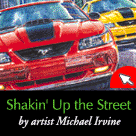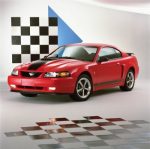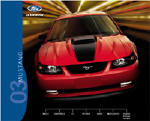| MAIN MENU | Home Page | FAQ's / Q&A's | Tech Specs | Mach 1 History |
Message Forums Over 1 Million Messages !! |
News | Photos | Online Chat | Wallpaper | Links |
Products & Accessories |
OWNER'S SECTION | Register Your Mach 1 | Owner's List | License & Tags | Photo Gallery |
| VIN Decoder | Production No's | CONTACT US | Contact Us | Advertising | Donations/Support |
|
Official Ford
Performance |
|
*SPECIAL PURCHASE* |
 |
|
MACH 1 LIMITED EDITION
PRINT |
|
**NEW & HOT** |
| 2003-04 Mustang |
|
2003
Brochure Available |
| HOT *NEW* PRODUCTS |
|
|
|
MUSTANG
MACH 1 SHAKES BACK TO STREET NEW YORK, March 27, 2002 – The Ford Mustang Mach 1 is shaking back to the street – complete with the signature "shaker" hood scoop that made it one of the most collectable Mustangs ever.  The new 2003-model Mustang Mach 1 special edition makes its debut at
the New York International Auto Show – 38 years after the original
Mustang was introduced in New York. The new 2003-model Mustang Mach 1 special edition makes its debut at
the New York International Auto Show – 38 years after the original
Mustang was introduced in New York.In March 1969, the Mustang Mach 1 was named “the quickest four-person production car” ever tested by Car Life magazine, earning it a chapter in the history of automotive enthusiasm and securing its legacy for the future. The 1969 Mach 1 looked like it was in motion, even at a stoplight, thanks to the shaker hood scoop. “Of all our Living Legends, Mustang might have the richest heritage. While everyone has a favorite, Mach 1 is one of the most memorable and most collectable Mustangs,” says Jim O’Connor, Ford Division president. The 2003 Mach 1 is expected to deliver more than 300 horsepower from its modular (MOD) 4.6-liter, 4-valve, DOHC V-8 engine when it goes on sale at the end of this year. The preeminent pony car remembers its roots with functional performance upgrades and Mach 1 styling cues, including “comfort-weave” leather seats, a shaker hood scoop and today’s interpretation of classic “Magnum 500” chrome wheels. Ford, which builds approximately 160,000 Mustangs each year, will build 6,500 Mustang Mach 1 special editions – on the same line of the Dearborn Assembly Plant that produces the V6, GT and Cobra Mustangs. Each Mach 1 will come with a unique serialization found in the vehicle identification number (VIN) to ensure exclusivity and collectibility. The Mach 1 is the newest derivative to join Ford’s Living Legends lineup of cars, which includes Mustang, Thunderbird, the new GT40 and the Forty-Nine concept. Mach 1 pricing and detailed technical specifications will be announced just prior to public introduction. Mach 1 History The Ford Mustang was introduced 38 years ago and has earned its place as a true American legend. From its inception, Mustang took the automotive world by storm, spawning fan clubs of enthusiastic baby boomers that were just coming of driving age in the mid-1960s. It seemed everyone wanted a Mustang and Ford was all too happy to provide one. In the first year, Ford sold more than 600,000 Mustangs. Derivatives came quickly as customers wanted to personalize their Mustang. There were numerous body styles, from coupe to fastback to convertible, and scores of powertrain and styling packages. The original Mach 1 was introduced in 1968 as a concept car with a hatched fastback, aggressive hood and side scoops and a unique paint scheme. In 1969, the Mach 1 was one of three new Mustang models that made it into production. It featured the familiar fastback body with simulated side scoops high on the quarter panel, an aggressively raked air dam on the front and a spoiler on the rear, “comfort-weave” leather seats and the now famous, “shaker hood scoop” mounted directly onto the carburetor and fitting through an opening in the hood. Underneath, the 1969 Mach 1 offered a 250-horsepower 351 Cleveland V-8 or a 335-hp 428 Cobra-Jet mill. Mach 1 and its stablemate, the Boss 302 Mustang, reenergized the fastback, tripling sales of the body style in 1969. The much smaller Mustang II model, introduced in 1974 as a response to the nation’s “energy crisis,” was the weaker sibling to its older muscle car brothers. The 1974 Mach 1 featured a 2.8-liter V-6 with dual exhaust while the other Mustangs of the period carried 2.3-liter I-4s as the base engine. Muscle Car Reborn Newer, more efficient V-8 engines brought Mustang back to its roots in the 1980s and 1990s. In 1994, the Mustang was completely redesigned with many of the popular styling cues of the original pony cars restored. The new car featured a long nose, short rear deck, “C-scoops” on the sides, three-element tail lamps and the return of the galloping pony emblem on the grille. Mustang sales once again soared to the lead in its segment. The high-revving, highly efficient, overhead-cam MOD 4.6-liter V-8 replaced the pushrod 5.0-liter V-8 in 1996 and assured Mustang’s longevity as a modern-day muscle car for years to come. The Mustang was freshened again with a new, edgier design in 1999. Today’s Mustang Just as the originals in 1964, the modern Mustang is a leader. It stands alone in its class, as the cross-town rivals, who in 1968 rushed to create a competitor to the original pony car, have now quietly departed the segment. Mustang has led its class for more than 15 years and is the best-selling convertible in the United States. Today, Ford uses some of the same techniques it did in the 1960s to keep Mustang fresh by offering buyers a wide range of personalization options to meet their needs and pique their enthusiasm for driving. Mustang is offered as a V-6, a Mustang GT with a MOD 4.6-liter, two-valve V-8 and the top-of-the-line Mustang Cobra SVT with a supercharged MOD 4.6-liter DOHC four-valve V-8, all available in coupe and convertible body styles. Special limited-edition models, such as the Bullitt GT in 2001 and the new Mach 1 are designed to offer collectors and enthusiasts a modern Mustang with an infusion of muscle-car memories. They keep the flame of pony car passion lit today and promise a bright future.  “A powerful nameplate like Mustang doesn’t come around too often in our business,” says O’Connor. “Our lineup of Mustangs and special edition models are designed to turn today’s customers into tomorrow’s enthusiasts. Mach 1 is a glance in the mirror of Mustang’s storied past, but it’s steering straight into the future of Mustang and promises that there will always be a Mustang in the Ford lineup.” 2003 Mustang Mach 1 The new Mustang Mach 1 was born out of the passion of Mustang enthusiasts across America. Team Mustang, fresh on the success of the 2001 Mustang Bullitt GT, created a “one-off” project car in the summer of 2001 and took the car to various Mustang Club events across the country. The Mach 1 was shown, not as a concept car, but as an experiment to test the market of Mustang fans for more special editions. “People dropped their jaws when they saw the Mach 1 for the first time, especially when we blipped the throttle to demonstrate the shaker,” says Scott Hoag, Mach 1 program manager. “These grassroots events started chats all over the Internet of fans telling us to build this car.” The project received the green light in the fall of 2001 as a limited-edition model designed to bridge the gaps between the past, the present and the future of Mustang.  The Scoop on Design The Scoop on DesignMach 1 was designed in Ford’s Living Legends Studio in Dearborn, Michigan, where all other Mustangs, plus the Thunderbird and the GT40, are designed. The Living Legends Studio, which also directed the design of the Forty-Nine concept through Ford’s California Design Studio, was created in July of 2000 to bring together the creativity of designers involved in related iconic cars of the present and future. “Ford is known for great trucks and SUVs,” says J Mays, Ford Motor Company vice president of Design. “But it’s our Living Legends that put the polish on the Ford oval and make people dream about cars again.” The Mach 1 features exterior enhancements that visually and emotionally connect it to the 1969 Mach 1 fastback. Perhaps the most visually arresting and totally unique design cue on the Mach 1 is the “shaker scoop.” But in keeping with performance Mustang heritage, the scoop is not only appearance enhancing, but functional. The “ram air” scoop, fitted through an opening in the hood, channels fresh air directly to the intake runners increasing the breathing and optimizing intake turbulence for improved power and torque. The scoop operates on similar principals to that of its forebear, but because the 1969 Mach 1 was a carbureted engine, it was a much simpler task to mount the scoop atop the carburetor in place of a traditional air cleaner. The “shaker scoop” on the 2003 Mach 1 is mounted atop the intake manifold and directs air through a secondary filter box to the intake. The intake also pulls cool air from the front grille to ensure free breathing. “At first, our colleagues from other teams thought we were crazy,” says Hoag. “After all, modern engines are so well tuned and balanced, there really is no ‘shake,’ so people asked why we would bother with a ‘shaker’ hood. But Team Mustang is full of enthusiasts who know what it’s like to pull a Mach 1 up next to a Chevelle SS with cowl induction and show off.” The scoop and the center powerdome hood are finished in low-gloss black. The C-pillars feature a unique trim appliqué that gives the roofline a subtle throwback appearance and distinguishes the car further from a GT. To enhance the low-to-the-ground appearance, the car features more prominent rocker-panel moldings and another classic Mach 1 trait, an air dam extension, painted low-gloss black. A low-gloss black stripe runs the length of the side just above the rocker moldings.  Mach 1 is available in Oxford White, Black, Torch Red, Zinc Yellow,
Azure Blue and Dark Shadow Gray clearcoat finish. Mach 1 is available in Oxford White, Black, Torch Red, Zinc Yellow,
Azure Blue and Dark Shadow Gray clearcoat finish.The experience of sitting inside Mach 1, with its woven leather seats, is a blast from the past. The seats are covered in one-of-a-kind “comfort weave” black leather that is reminiscent to the material that was unique to the original Mach 1. The seats offer increased lateral support and four-way adjustable head restraints. The center stack and shifter bezel are painted in a gray accent finish and highlighted by an aluminum shift boot ring and aluminum shifter ball. The accelerator, brake, clutch and dead pedals are polished aluminum. The gray-backed instrument cluster features unique retro-look dials. Mach 1 comes standard with the Mach 460 six-disc in-dash CD changer audio system. |
|
The MOD 4.6 The powerplant that shakes the scoop and the competition is a MOD 4.6-liter, 4-valve, dual-overhead-cam V-8. The engine makes use of specially calibrated cams, a modified upper intake to accommodate the ram-air system, a heated PCV, a forged crank (cast crank in automatic transmission application) and performance exhaust manifolds combining to produce an expected output in excess of 300 horsepower. Upon completion of testing and certification, actual horsepower and torque data will be available. Putting the Power to the Road The 2003 Mach 1 will be available with a choice of a five-speed manual or a four-speed automatic transmission with electronic overdrive. The 4R70W automatic transmission is upgraded with a heavy-duty gear-set, auxiliary fluid cooler and brazed 11.25-inch torque converter to withstand the added power of the Mach 1's MOD 4.6 V-8. Mach 1 uses a new rear axle with a high-torque differential and a 3.55:1 axle ratio. Mach 1's suspension matches its power with crisp road manners. The vehicle is lowered one-half of an inch compared to the GT and uses a firmer suspension for better-balanced ride and improved handling characteristics. The performance-handling package includes: New front and rear coil springs with adapted load and rate Re-valved Tokico© struts in front and shocks in rear Unique stabilizer bars front and rear Added frame rail connectors to stiffen the body Thirteen-inch Brembo® front rotors and performance calipers provide excellent stopping capability. The calipers have a black-anodized finish and are visible through 17-inch Magnum 500 wheel spokes when the car is parked, or when it is cruising the streets. Mach 1 comes standard with ABS and traction control. |
Source: Ford







